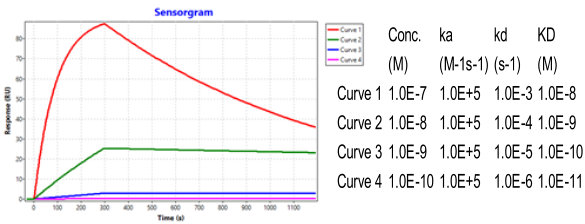This forum is intended for questions about kinetics, Surface Plasmon Resonance and the instruments related to these techniques.
too strong koff
- Nad
- Topic Author
- New Member
-

Less
More
- Thank you received: 0
4 years 4 months ago - 4 years 4 months ago #1
by Nad
too strong koff was created by Nad
Hi guys,
I'm wondering that:
If I have a binder which forms a very stable complex with a flat kOff in the sensorgrams, what happened to the profile of the kon in the sensorgrams? could be an artefacted kon?
And could the koff (or kon) profile be affected to the fact that a too high amount of ligand is capture on the sensorchip surface? Sure I cannot reach saturation but what happened to the kinetic parameters, they are still corrected?
Thank you in advance
Nadine
I'm wondering that:
If I have a binder which forms a very stable complex with a flat kOff in the sensorgrams, what happened to the profile of the kon in the sensorgrams? could be an artefacted kon?
And could the koff (or kon) profile be affected to the fact that a too high amount of ligand is capture on the sensorchip surface? Sure I cannot reach saturation but what happened to the kinetic parameters, they are still corrected?
Thank you in advance
Nadine
Last edit: 4 years 4 months ago by Nad.
Please Log in or Create an account to join the conversation.
- Arnoud
- Moderator
-

Less
More
- Thank you received: 0
4 years 4 months ago #2
by Arnoud
Replied by Arnoud on topic too strong koff
In the figure is a simulation of four curves each with a lower kd. The analyte concentration is set to 10x KD to better compare what is happening.
The association with fastest kd gives a good curvature so the ka can be resolved with confidence. However the other curves have too little curvature to determine the ka. Thus, the analyte injection time must be longer with slower dissociations. You need long injection times to get curvature when the dissociation is slow. In general the injection time is limited by the maximal injection volume.
One other solution is to inject a higher concentration analyte but as soon you go over 100x KD you can expect non-linear behaviour of the curves due to crowding and possible low affinity interactions.
Adding more ligand to the surface does not help in this case. A too high ligand amount will give mass-transport limitation in combination with low flow rates (<50 µl/min) and high analyte concentrations.
One solution is pointed out in the topic: Cannot Find the Kd of Antibody.
Arnoud
The association with fastest kd gives a good curvature so the ka can be resolved with confidence. However the other curves have too little curvature to determine the ka. Thus, the analyte injection time must be longer with slower dissociations. You need long injection times to get curvature when the dissociation is slow. In general the injection time is limited by the maximal injection volume.
One other solution is to inject a higher concentration analyte but as soon you go over 100x KD you can expect non-linear behaviour of the curves due to crowding and possible low affinity interactions.
Adding more ligand to the surface does not help in this case. A too high ligand amount will give mass-transport limitation in combination with low flow rates (<50 µl/min) and high analyte concentrations.
One solution is pointed out in the topic: Cannot Find the Kd of Antibody.
Arnoud
Please Log in or Create an account to join the conversation.
- Nad
- Topic Author
- New Member
-

Less
More
- Thank you received: 0
4 years 4 months ago #3
by Nad
Replied by Nad on topic too strong koff
Really thank you for your kind replay!
Nadine
Nadine
Please Log in or Create an account to join the conversation.
Moderators: Arnoud, Arnoud
